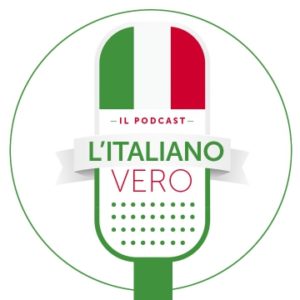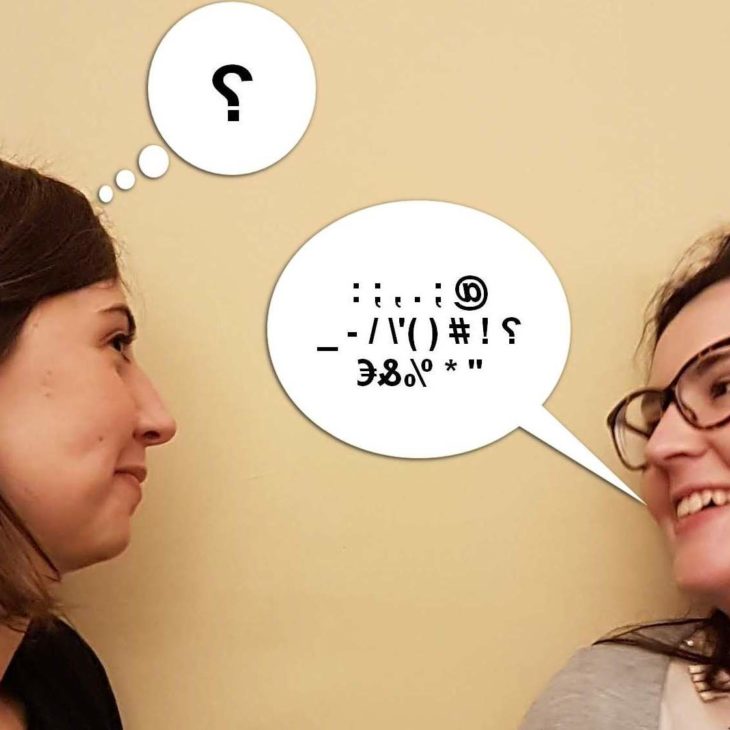Blog in Italiano
Proseguiamo insieme a Cubo, Paolo e la graditissima e preparatissima Paola il viaggio alla scoperta dell’affascinante mondo della punteggiatura e dei caratteri speciali.
Paola “fa gli onori di casa” aprendo l’episodio e introducendone il tema: i caratteri speciali parte seconda. Paola fa notare che i caratteri dell’episodio avranno meno a che fare con la punteggiatura utilizzata in ambito scolastico o con la scrittura di testi ma sono più caratteri utilizzati che potrebbero riguardare da vicino Paolo e Massimo nella loro quotidianità in ufficio, diciamo che sono caratteri speciali da “colletti bianchi”.
Massimo chiede a Paola, maestra di scuola primaria, di ricordare il metodo che usa per scoraggiare i bambini a parlare il dialetto bergamasco, molto diffuso nei paesi e nelle valli di Bergamo. Paola racconta allora che al primo episodio richiama verbalmente i bambini e alla seconda scrive una nota di demerito sul diario. Ahh quanto è severa la nostra maestra!! ;-)
Gli ospiti comunque sono tutti d’accordo sul fatto che l’Italia e il mondo intero sono belli proprio per le caratteristiche dei loro dialetti.
I caratteri speciali raccontati in questo episodio, così come li chiamano gli italiani veri, sono:
- ‘ apostrofo: Paola ci ricorda come spesso venga omesso o utilizzato in maniera impropria anche dagli italiani. Paola usa una bella espressione per definire il fatto che che spesso sia fonte di “dolori” ma anche di gioia: “croce e delizia”.
- L’apostrofo si usa in italiano principalmente, quando si hanno due parole consecutive, in cui la prima finisce con una vocale e la seconda comincia con una vocale; la vocale della prima parola sparisce e viene sostituita dall’apostrofo. Ad esempio “la amica” diventa “l’amica” Massimo a questo punto ricorda una famosa poesia (del poeta francese Edmond Rostand autore del Cyrano de Bergerac) che definisce l’apostrofo: Un bacio, insomma, che cos’è un bacio? Un apostrofo rosa fra le parole t’amo. Da notare la traduzione inglese della poesia, in quanto l’espressione “I love you” non contiene l’apostrofo, così nella traduzione si è fatto riferimento al punto esclamativo: What is a kiss? It is the pink exclamation mark that comes after “I love you!”.
- / barra: nella tastiera italiana è posizionata insieme al tasto del numero 7, per non confonderla con l’altra barra (\) viene chiamata “barra sopra il 7”. Utilizzata oltre che negli indirizzi internet anche come simbolo delle divisioni e delle frazioni.
- \ barra: chiamata “barra” come la precedente , viene usata meno e alle volte viene specificato “quella vicina al tasto ESC”
- – trattino: o anche “trattino alto” o “meno” in quanto viene utilizzato per indicare il simbolo delle sottrazioni
- _ trattino basso: o all’inglese “underscore”
- “ virgolette: vengono utilizzate per indicare una citazione nella lingua scritta, oppure nella lingua parlata, “tra virgolette”, mentre le disegna in aria con le dita, per suggerire che sta dicendo quella cosa, sì, ma in un altro senso: allusivo, ironico, metaforico. Massimo aveva detto all’inizio dell’ episodio “punire tra virgolette” riferendosi non ad una punizione vera e propria in senso fisico ma più appunto in senso metaforico.
- * asterisco: per inserire un richiamo ad esempio a piè di pagina o per omettere volutamente alcuni caratteri come ad esempio i numeri della carta di credito. Il suo nome sembra che derivi dal latino medievale astericolum, piccola stella. Fonte: Wikipedia
- % percentuale: a Paola piace molto perché la associa ai saldi :-)
- & e commerciale: non è molto utilizzata in italiano, viene usata nelle denominazioni delle società insieme all’abbreviazione CO. ad esempio IL CUBO & CO.
- € euro: è il simbolo della moneta europea e se non fosse presente sulla tastiera può essere digitata con la combinazione di tasti Altgr+E
Massimo ricorda che è possibile esercitarsi nell’apprendimento dei caratteri speciali col quizlet preparato per l’occasione: https://quizlet.com/379275823.
L’episodio si chiude con i saluti finali e con la promessa di Paola (sarà vero ?) di tornare a trovarci nei prossimi episodi.
Blog in italiano by Massimo
Blog in English
With Cubo, Paolo, and (our very well prepared) Paola, we continue the journey to discover the fascinating world of punctuation and special characters.
In this episode, Paola “does us the honors” of introducing the theme of the episode: special punctuation, part two. Paola points out that the punctuation will have less to do with the puncuation learned in writing, but more how they are used in every day life. They are the characters special to “colletti bianchi” (“white collar”) work.
Massimo asks Paola, a primary school teacher, to remember the method that she uses to discourage children from speaking the Bergamo dialect, which is very common in the towns and valleys of Bergamo. Paola told Cubo and Paolo in the first episode that she corrects them verbally in the classroom and notes a demerit in her teacher’s book. Ah! Our teacher is so severe! ; )
However, even Paola would agree that Italy — and the whole world — are more beautiful precisely because of characteristics of dialects.
In this episode, we will examine some of these special characterisitcs and how the real Italians use them.
- ‘ Apostrophe: Paola reminds us that this is often omitted or used improperly by most Italians. She uses a beautiful expression to say that is just as much a source of “pain” as it is of joy: “croce e delizia” (cross and delight).
The apostrophe is used in Italian when you have two consecutive words, in which the first ends with a vowel and the second begins with a vowel; the vowel of the first word disappears and is replaced by the apostrophe. For example: the friend (la amica) becomes “l’amica.”
Massimo remembers a famous pome by French poet Edmond Rostand (author of Cyrano de Bergerac) that defines the apostrophe: Un bacio, insomma, che cos’è un bacio? Un apostrofo rosa fra le parole t’amo (A kiss, in short, what is a kiss? A pink apostrophe in the words I love you). But notice how in the English translation, we lose the apostrophe, and therefore, some of the meaning is lost.
- / barra: In the Italian keyboard, we find the “barra” positioned together with the number 7 key, and so we sometimes call it “barra sopra il 7” (the bar above 7). We use this not only in Internet addresses, but also as a symbol of divisions and fractions.
- \ barra : This is called “barra” like the previous one. It is used less, and we sometimes call it “quella vicina al tasto ESC” (the one next to the ESC key)
- – trattino : We might use this as “trattino alto” (top hyphen) or “meno” (minus).
- _ trattino basso : “Underscore” like in English
- “ virgolette : “Inverted commas.” We use these to indicate a quotation in the written language. Or, in the spoken language, “tra virgolette (in quotation marks),” while drawing them in the air with the fingers, to suggest that the thing said was allusive, ironic, or metaphorical. Massimo sadi in the beginning of the episode “punire tra virgolette” (to punish in quotation marks) to refer not to real punishment, but in a more metaphorical sense.
- * asterisco : We might use these to insert at the bottom of the page to indicate footnotes. Or, we may deliberately omit some characters, such as credit card numbers, and use “asteriso” instead. The name is derived from the medievel Latin word, astericolum.
- % percentuale : Paola really likes this one because she associates it with sales :-)
- & e commerciale : This is not as widely used in Italian, but may be used in company names, with the abbreviation of company. For example: IL CUBO & CO.
- € euro : This is the symbol of the European currency. If it is not on the keyboard, you can use Altgr+E to get it.
Massimo reminds us that we can use Quizlet flashcards to learn this new vocabulary: https://quizlet.com/379275823.
Cubo and Paolo end the episode with farewell greetings to Paola. Paola promises to return to join us in future episodes.
Blog in English by Lee Okan
 Settembre 9, 2019
Settembre 9, 2019 24 min
24 min Luglio 29, 2019
Luglio 29, 2019 13 min
13 min Luglio 15, 2019
Luglio 15, 2019 24 min
24 min Luglio 1, 2019
Luglio 1, 2019 15 min
15 min Giugno 17, 2019
Giugno 17, 2019 21 min
21 min Maggio 30, 2019
Maggio 30, 2019 29 min
29 min Maggio 9, 2019
Maggio 9, 2019 21 min
21 min Aprile 30, 2019
Aprile 30, 2019 28 min
28 min Aprile 17, 2019
Aprile 17, 2019 15 min
15 min Aprile 10, 2019
Aprile 10, 2019 24 min
24 min Aprile 3, 2019
Aprile 3, 2019 24 min
24 min Gennaio 26, 2020
Gennaio 26, 2020 21 min
21 min Gennaio 12, 2020
Gennaio 12, 2020 20 min
20 min Dicembre 29, 2019
Dicembre 29, 2019 24 min
24 min Dicembre 15, 2019
Dicembre 15, 2019 21 min
21 min Dicembre 1, 2019
Dicembre 1, 2019 12 min
12 min Novembre 17, 2019
Novembre 17, 2019 min
min Novembre 3, 2019
Novembre 3, 2019 20 min
20 min Ottobre 20, 2019
Ottobre 20, 2019 14 min
14 min Ottobre 7, 2019
Ottobre 7, 2019 9 min
9 min Settembre 23, 2019
Settembre 23, 2019 33 min
33 min Gennaio 9, 2024
Gennaio 9, 2024 6 min
6 min Dicembre 2, 2022
Dicembre 2, 2022 31 min
31 min Ottobre 8, 2022
Ottobre 8, 2022 18 min
18 min Dicembre 25, 2021
Dicembre 25, 2021 1 min
1 min Settembre 18, 2021
Settembre 18, 2021 21 min
21 min Agosto 14, 2021
Agosto 14, 2021 17 min
17 min Maggio 4, 2020
Maggio 4, 2020 32 min
32 min Aprile 12, 2020
Aprile 12, 2020 41 min
41 min Agosto 26, 2019
Agosto 26, 2019 18 min
18 min Agosto 12, 2019
Agosto 12, 2019 11 min
11 min Giugno 5, 2019
Giugno 5, 2019 9 min
9 min






Leave a Comment